I use Google Translate extensively when I travel because it happens to be the only go-to translation app, since it’s free and pre-installed on my phone. Even though it is one of the most widely used translation tools in the world, I often discover its limitations the hard way, especially when trying to have meaningful conversations or get help in unfamiliar countries. So I took the liberty to do my own offline and online surveys on people’s experiences with this common app, and here are the five common problems you might face.
1. They Don’t Understand How to Use Google Translate
Not everyone is familiar with Google Translate. I know I recently updated my Google Translate app from a much older version to the latest, and I still get lost with the new user interface.
Moreover, some people may have never used Google Translate before. This is particularly true among elderly individuals or those in rural areas. When you pass your phone to them, they might not know how to switch languages, use voice input, or even find the keyboard. What was meant to be a simple communication aid can suddenly become a confusing interaction.
However, we can’t squarely blame this on Google Translate. I also got lost when I needed to use my spouse’s iPhone. I can’t even find the auto-rotate screen button!
2. Passing Your Phone to Others
When you don’t speak the local language, it’s common to type something into Google Translate and then hand your phone over to the other person. There’s an elderly street vendor in Seoul whom I often visit to indulge in her delicious “bungeo-ppang”, a fish-shaped pastry stuffed with red bean paste. We often tried to get into a conversation, and each time I flashed my phone for her to speak to Google Translate, she looked at me with an odd face. This awkward scenario commonly plays out whenever I’m in a taxi or restaurant as well.
Many people, including me, hesitate to pass our phones to strangers, and it’s easy to misunderstand our intention. For those who understand us, we often lose track of who is supposed to type next. It turns a conversation into a back-and-forth transaction rather than a natural exchange.
3. Not Accurate and Sometimes Outright Rude
Google Translate can struggle with slang, idioms, typos, and poorly formed sentences. The result is sometimes a sentence that sounds robotic, confusing, or even unintentionally rude.
My Korean in-laws never liked my Google-translated Korean text. They find it impolite. So I had to switch to Papago, which translates better to Korean, even though it’s limited to only a handful of languages.
Machine-translated phrases may come off as overly formal, awkward, or contextually inappropriate, which can hurt feelings or create uncomfortable situations, particularly in places where politeness and tone are important.
4. Best Used When Face to Face
Google Translate only works best if you’re physically with the person you’re trying to communicate with. This means you can’t use it to chat with someone online except with a huge load of copying and pasting. This can become a sheer chore to handle. Imagine going back and forth between WhatsApp and Google Translate, just to translate a text that meant to say “How are you?” Or try using Google Translate for every message on a foreign chat group. You’ll know what I mean.
Google Translate is fine for quick questions on the street, but it doesn’t help when you want to keep in touch with a tour guide, local contact, or a new friend after you part ways.
5. There’s No Chat History
Although Google Translate provides the feature that saves translation history, there isn’t one when you communicate with a certain individual. In countries like Japan, a historical record of previous conversations with a person is highly sought after. That is why many translation devices can still survive in the Japanese market even with Google Translate around.
This is critical when we converse in a business setting, where we need to refer back to read what was said. Something like a minute of a meeting.
6. Web Page Translation Is Worse Than the App Itself
If you try to use Google Translate to read local websites, like online forums or booking pages, it often produces clunky or broken translations. Layouts get distorted, buttons don’t work properly, and the meaning of key information gets lost. So I usually find myself using the mobile app to scan my PC’s screen just to get the exact meaning of some foreign words. This shows that the built-in Google Translate on Chrome browser may be decent for simple webpages, but when the pages get tough, the tough translation doesn’t get going.
The Bottom Line
Google Translate is a helpful software tool, but it wasn’t designed to handle full conversations or culturally sensitive language in real time. As a traveler, you need more than just word-for-word translation; you need something natural, intuitive, and universally accessible.
Newer tools are now available, and they are designed with travelers in mind. They provide real-time, AI-powered translation in a chat format that feels natural and doesn’t require face-to-face interaction or app downloads from the other person. Whether you’re on a guided tour, in a taxi, or trying to ask for help in a hospital, better options are emerging to make cross-language communication smoother than ever.
